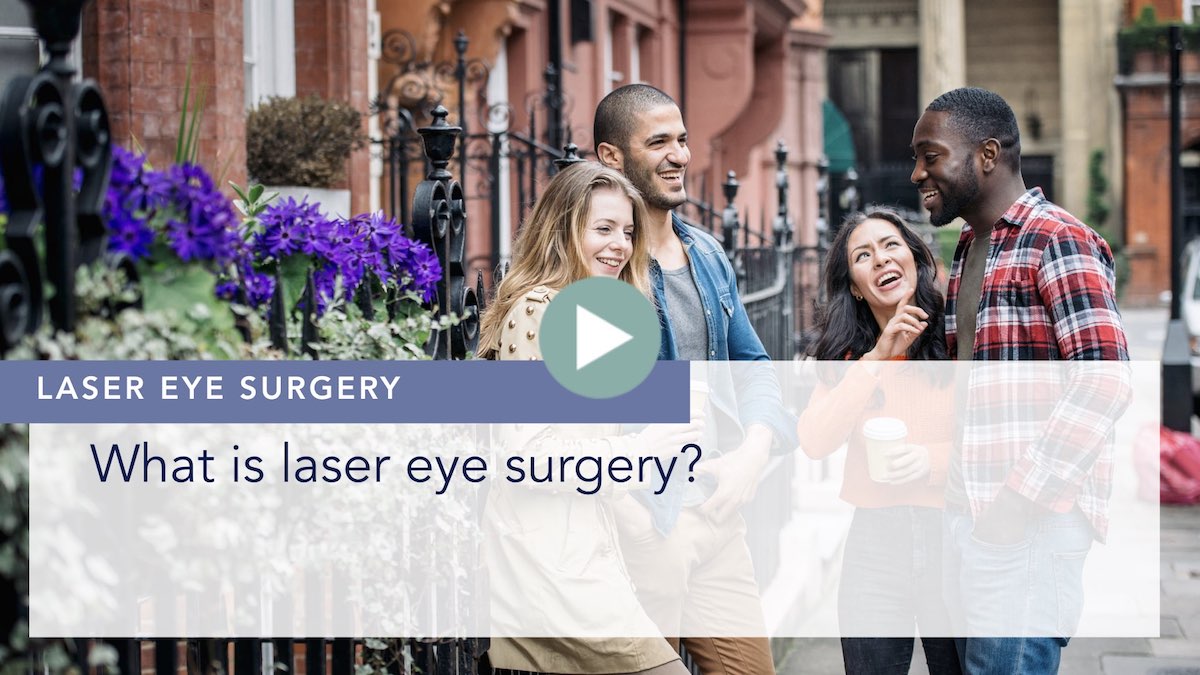Interview transcription
We interviewed Alex Shortt to find out about the different types of laser eye surgery, how they work and how they have evolved over the years.
Interviewer: How does laser eye surgery actually work?
Alex Shortt: When we wear glasses or contact lenses, we’re effectively wearing a lens to bend light and correct the imperfect shape of the eye. With laser eye surgery, we are effectively sculpting that correction onto the surface of the cornea, which is the clear window at the front of the eye. By sculpting the prescription onto the eye we neutralise or correct the imperfections. That’s the way most laser eye surgery procedures work.
Interviewer: How do you do that?
Alex Shortt: There are two main ways of doing it. So the older generation of lasers – the first and second generation of laser eye surgery known as PRK or LASEK – involved performing the laser treatment directly onto the surface of the eye. That unfortunately left patients with effectively a large scratch on the surface of their eye which can be very sore for a couple of days afterwards. It’s a very safe and accurate treatment, but it’s very sore.
Very rarely we still perform this first generation surgery for patients with specific prescriptions or indications.
LASIK
During the late nineties and into the two thousands, LASIK became the gold-standard treatment of choice. The reason why this was a complete revelation was that it is entirely and utterly painless afterwards. There is minor watering and irritation of the eye, but it’s astonishing how quick and pain-free it is for a patient.
What happens in LASIK is we create a very thin flap on the surface of the cornea using a laser. Now in the old days, we used to use a blade, and that put people off. That does not happen anymore. There is no such thing as a blade used in laser eye surgery. We use a laser to make a very thin flap in the cornea, and we peel it open. We then sculpt the prescription inside the cornea and place the flap back down. The eye is unaware that any treatment has taken place.
There is a little bit of watering and irritation for a couple of hours afterwards, but it is truly minor. Within twelve to 24 hours, the vision is crystal clear, and the fact that there are minimal symptoms and no pain afterwards has revolutionised laser eye surgery.
However, despite all the brilliant things about LASIK, there are some issues that occasionally cause problems. For example, if the patient is a boxer or does contact sports such as rugby, they are at risk of a direct blow to the eye which could potentially tear open the LASIK flap, even 20 to 30 years down the line.
The worst case of this that I’ve seen, is someone who was involved in a road traffic accident. The airbag went off and hit their face, compressing both the eyes and causing both laser flaps to be torn clear off – even 20 years after their original treatment. So, although it’s very rare, it’s a worry for some people.
A second issue with LASIK is that when we make this flap we actually cause quite a bit of damage to the nerves in the cornea. The nerves recover, but it can take between six and twelve months for them to fully recover. As they’re recovering we occasionally see severe dryness of the cornea, because these nerves are critical in telling your eye it needs to make more tears. But if they’re damaged, your eye doesn’t know it needs to water.
Interviewer: Are there any other issues with LASIK such as problems with night vision or halos?
Alex Shortt: These are issues that are very much historical now. In the early days, when we were doing laser treatment we used to create a 4 mm or 5 mm treatment zone in the middle of the eye. In doing this, there was a sharp boundary between the treated part of the cornea and the edge. What would happen, is the light would bounce off the edge of the treatment zone making it harder to see at night. So very simply, we just made the treatment zone bigger and added an extra zone – what we now call the blend zone – where we very carefully smooth the transition between treated and non-treated cornea together. Since we’ve done that, I can’t remember the last time I’ve seen a single patient who has had a single problem with night vision. However, we still need to tell patients about this as it’s out there in the literature.
If you’d like to know more about vision corrective surgery, book a free initial screening today and I will personally answer your questions. Alternatively, take our free suitability quiz to find out which treatment you are suitable for.

About the author
Mr Alex J. Shortt | Consultant Ophthalmic Surgeon
MB BCh MSc PhD FRCOphth PGDipCatRef
I’m Alex Shortt, a highly trained academic researcher and Consultant Ophthalmic Surgeon based in London’s famous Harley Street medical district. I trained and worked as a consultant for 14 years at London’s Moorfields Eye Hospital. I specialise in advanced technologies for correcting vision, including cataract surgery, implantable contact lenses and laser vision correction.






